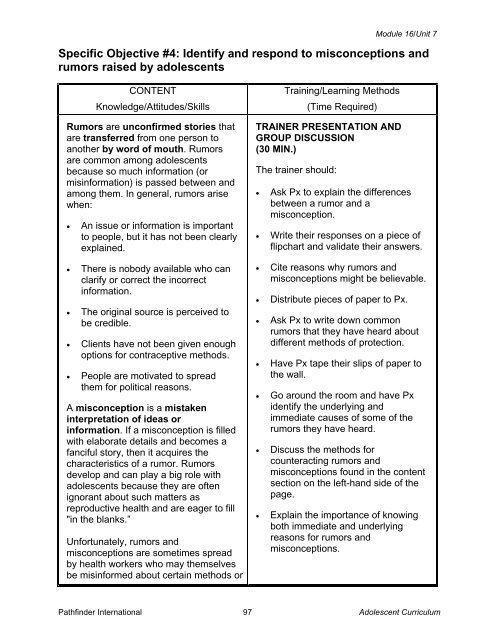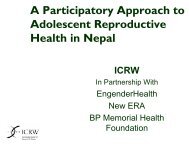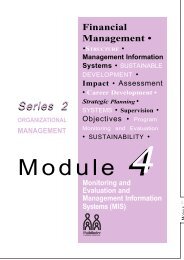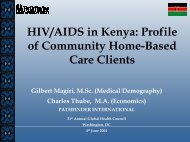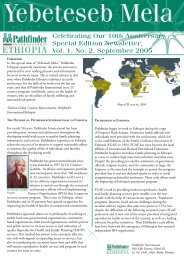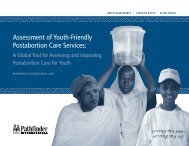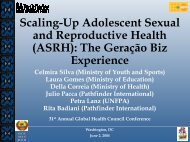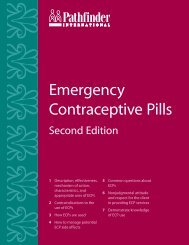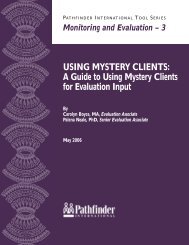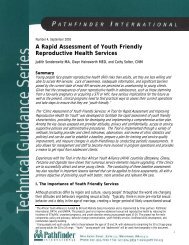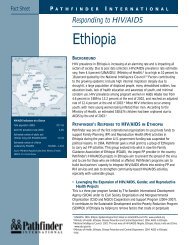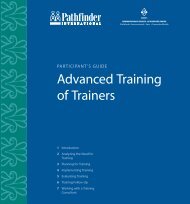reproductive health services for adolescents - Pathfinder International
reproductive health services for adolescents - Pathfinder International
reproductive health services for adolescents - Pathfinder International
You also want an ePaper? Increase the reach of your titles
YUMPU automatically turns print PDFs into web optimized ePapers that Google loves.
Module 16/Unit 7<br />
Specific Objective #4: Identify and respond to misconceptions and<br />
rumors raised by <strong>adolescents</strong><br />
CONTENT<br />
Knowledge/Attitudes/Skills<br />
Rumors are unconfirmed stories that<br />
are transferred from one person to<br />
another by word of mouth. Rumors<br />
are common among <strong>adolescents</strong><br />
because so much in<strong>for</strong>mation (or<br />
misin<strong>for</strong>mation) is passed between and<br />
among them. In general, rumors arise<br />
when:<br />
• An issue or in<strong>for</strong>mation is important<br />
to people, but it has not been clearly<br />
explained.<br />
• There is nobody available who can<br />
clarify or correct the incorrect<br />
in<strong>for</strong>mation.<br />
• The original source is perceived to<br />
be credible.<br />
• Clients have not been given enough<br />
options <strong>for</strong> contraceptive methods.<br />
• People are motivated to spread<br />
them <strong>for</strong> political reasons.<br />
A misconception is a mistaken<br />
interpretation of ideas or<br />
in<strong>for</strong>mation. If a misconception is filled<br />
with elaborate details and becomes a<br />
fanciful story, then it acquires the<br />
characteristics of a rumor. Rumors<br />
develop and can play a big role with<br />
<strong>adolescents</strong> because they are often<br />
ignorant about such matters as<br />
<strong>reproductive</strong> <strong>health</strong> and are eager to fill<br />
"in the blanks.”<br />
Un<strong>for</strong>tunately, rumors and<br />
misconceptions are sometimes spread<br />
by <strong>health</strong> workers who may themselves<br />
be misin<strong>for</strong>med about certain methods or<br />
Training/Learning Methods<br />
(Time Required)<br />
TRAINER PRESENTATION AND<br />
GROUP DISCUSSION<br />
(30 MIN.)<br />
The trainer should:<br />
• Ask Px to explain the differences<br />
between a rumor and a<br />
misconception.<br />
• Write their responses on a piece of<br />
flipchart and validate their answers.<br />
• Cite reasons why rumors and<br />
misconceptions might be believable.<br />
• Distribute pieces of paper to Px.<br />
• Ask Px to write down common<br />
rumors that they have heard about<br />
different methods of protection.<br />
• Have Px tape their slips of paper to<br />
the wall.<br />
• Go around the room and have Px<br />
identify the underlying and<br />
immediate causes of some of the<br />
rumors they have heard.<br />
• Discuss the methods <strong>for</strong><br />
counteracting rumors and<br />
misconceptions found in the content<br />
section on the left-hand side of the<br />
page.<br />
• Explain the importance of knowing<br />
both immediate and underlying<br />
reasons <strong>for</strong> rumors and<br />
misconceptions.<br />
<strong>Pathfinder</strong> <strong>International</strong><br />
97<br />
Adolescent Curriculum


